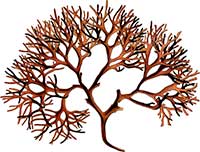Do you read the ingredients when you buy processed, packaged or prepared foods at the grocery store? If you’re interested in eating a wholesome diet, like I am, you might do a lot of research into nutritious meals and healthy ingredients to make sure you’re getting your daily vitamins and minerals. Maybe your research let you to Carma’s Cookery!
But, no matter how much research you do, can you be sure that your meal completely healthy? Unfortunately, food manufacturers add some dubious ingredients to preserve their food and give it a certain taste, color, or texture. Some of those additions are harmless, but others are not. The next time you go food shopping, scan the labels for some of these ingredients.
Ingredients Highlight #1: Carrageenan
 Carrageenan comes from an edible seaweed known as Irish Moss, and it is widely used in the food industry for its gelling, thickening, and stabilizing properties. The problem with carrageenan is that it’s not digestible and has no nutritional value.
Carrageenan comes from an edible seaweed known as Irish Moss, and it is widely used in the food industry for its gelling, thickening, and stabilizing properties. The problem with carrageenan is that it’s not digestible and has no nutritional value.
Carrageenan is particularly destructive to the digestive system, and it causes inflammation, leading to ulceration and bleeding. Other carrageenan side effects include leaky gut syndrome, cancer, and it has been linked to diabetes. Unfortunately, health enthusiasts are likely to have a lot of carrageenans in their kitchen, as it’s commonly found in almond milk, coconut milk, most organic foods, and some Starbucks drinks with soy milk.
Ingredients Highlight #2: Palm Oil
 When a regular fat like corn, soybean, or palm oil is blasted with hydrogen and turned into a solid, it becomes a trans fat. This might not mean much to you, but essentially it means that food with palm oil can sit on a supermarket shelf for years without rotting or growing stale.
When a regular fat like corn, soybean, or palm oil is blasted with hydrogen and turned into a solid, it becomes a trans fat. This might not mean much to you, but essentially it means that food with palm oil can sit on a supermarket shelf for years without rotting or growing stale.
If you’ve ever eaten food two years after you first bought it, you should be suspicious if it still tastes fine. Take a good look at those instant noodles. Also, eating junk food with trans fats raises your “bad” LDL cholesterol and triglycerides and lowers your “good” HDL. These fats also increase your risk of blood clots and heart attack.
Ingredients Highlight #3: Yellow #5 (Tartrazine/ E102)
 Yellow #5 is a synthetic lemon yellow dye widely used in the making of potato chips, jams, candy, drinks and even pet food. It is also added to shampoo and other cosmetic products.
Yellow #5 is a synthetic lemon yellow dye widely used in the making of potato chips, jams, candy, drinks and even pet food. It is also added to shampoo and other cosmetic products.
The Food Standards Agency in the UK issued a warning in 2008 that certain food colorings, including Yellow #5, caused behavioral changes in children that included loss of concentration and impulsive, hard-to-control activity. Yellow #5 has also been linked to asthma, migraines, thyroid cancer, anxiety, clinical depression, blurred vision, purple spots on your skin and unexplainable itchy skin.
Ingredients Highlight #4: High-Fructose Corn Syrup (HFCS)
 High-fructose corn syrup is a sweetener made from corn starch that has been processed by glucose isomerase to convert some of its glucose into fructose. It is sweeter and cheaper than regular sugar, and therefore it has become a staple ingredient in most processed food.
High-fructose corn syrup is a sweetener made from corn starch that has been processed by glucose isomerase to convert some of its glucose into fructose. It is sweeter and cheaper than regular sugar, and therefore it has become a staple ingredient in most processed food.
In fact, some studies have linked HFCS to the increasing obesity rates in America. Although households trying to eat well may have purged their cabinets of foods like soda, candy, salad dressing, and frozen junk food, HFCS can also be found in juice, bread, breakfast cereals, and even cough syrup.

Take Charge of Your Health!
Changing your eating habits can be tough. But it doesn’t have to be if you take a little time to think it out and create a plan.
This Healthy Eating Worksheet will walk you through the process of creating a healthy eating plan. All you need to do is print it out, set aside some time to complete it, and then fill it out. Then you can create your plan, knowing that you have addressed potential obstacles and came up with some creative ways to handle them.



